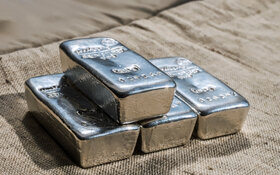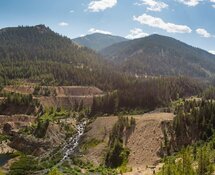The Mining Report: Copper has fallen about 12% in 2015 and other base metals are seeing significantly weaker support after the World Bank said it expects the global economy to slow by as much as 1% this year. Is the bull market for commodities over or is this a pause in an otherwise bullish cycle?
Stefan Ioannou: Looking at this market as bullish over the past couple of years may be a bit aggressive. There has been a cautious tone since 2012. Metal prices relative to historic prices are definitely higher, but so are operating costs. The margins haven't changed much. Depending on the metal you're talking about, there are also concerns about large surpluses and global economies possibly slowing down.
TMR: Would it be fair to say that while base metal prices may be under pressure in a broad sense, specific equities may have catalysts or other news that could offset commodity price weakness?
"Balmoral Resources Ltd.'s project portfolio includes the high-grade Grasset deposit in Quebec, where massive sulphide mineralization remains open in multiple directions."
SI: Well-run companies tend to do well, assuming they have a project that can demonstrate reasonable economics in a given pricing environment. However, in mid-January we witnessed a massive correction in the copper price—a lot of value has been taken off the table. When there are rapid drops like that it almost doesn't matter how great a project is. In the short term those companies will face general market sentiment, which tends to hit the panic button and exit the resource sector en masse. That reaction was probably overdone in terms of the response of the equities and their valuations. There is a bottom-fishing opportunity there.
TMR: What was the general sense at Haywood when you watched those corrections occurring?
SI: We tried to determine if a specific event caused copper to test and break the $2.50 per pound ($2.50/lb) support level and the simple answer is no. There's obviously some well-founded concern about global economies. When the oil price took a nosedive in Q4/14, that put all the commodities under the magnifying glass. Copper, essentially the master of the base metals, has been hit hardest.
TMR: Please give us your revised price decks in light of recent events.
SI: We're seeing $2.50/lb copper right now but there is room for the copper price to go lower. That is the market sentiment. Haywood's recently revised formal 2015 price is $2.50/lb, essentially in line with current spot pricing. Volatility aside, we anticipate the price will moderate around current levels this year. Our long-term outlook remains more bullish, underpinned by a formal forecast price of $3.25/lb. This is a cyclical market. In a couple of years we're going to deplete surpluses, and the cycle is going to turn.
TMR: What are your near-term and long-term prices for zinc and nickel?
SI: Our formal zinc price for 2015 is $1.10/lb, which is a notable move up from where it is right now, at just below $1/lb. The zinc market is an interesting space. Current inventories are still quite high, but they're being drawn down rather quickly. We have seen and are in the process of seeing large zinc mines shut down.
Over the last two years or so we've lost about 12% of world production and the advanced-stage projects slated to replace those mines are quite few—not enough to replace what we're losing. We are anticipating a move in the zinc price, probably later this year. Then in 2016 and 2017 we could see zinc prices really run, as in 2007, when zinc rose to $2/lb. Any company with zinc in its name or zinc in its business plan stands to do well. Looking further ahead we anticipate higher pricing will prompt more production, in turn moderating the market. Hence, we continue to use a long-term zinc price of $1.15/lb.
TMR: And nickel?
SI: Nickel is somewhere between copper and zinc. In 2014 we saw the Indonesian government enact a nickel export ban, which had notable market consequences. A lot of nickel has been taken off the table, which would have otherwise caused a surplus. There are rumblings as well that the Philippines may follow Indonesia's lead. It may not be an outright ban on nickel exports, but higher taxation is possible. The nickel market has come under a bit of a squeeze. We could see global nickel supplies switch from surplus to deficit by as early as mid-2015. That would be a major trigger point for nickel prices moving higher. For 2015 we are using $7/lb nickel. Our long-term price is $9/lb.
"North American Nickel Inc.'s high-grade nickel sulphide discovery in Greenland is associated with rocks similar to the world-class Voisey's Bay deposit."
TMR: Many of the base metals equities you cover are sensitive to even small commodity price swings. How do you account for a weaker base metal price environment in your 2015 equities investment thesis?
SI: We have to be cognizant of volatility in general. Massive swings on the order of $0.10 to $0.20/lb in a day have huge implications for the underlying equities that trade on multiples of the copper price. The general sentiment is that prices are going lower before they move higher, so you really want to stay away from leveraged plays. What makes a company leveraged? In general, the lower-grade mines are typically the higher-cost mines. That higher cost translates into more leverage. Small moves in the copper price, for example, have a significantly greater impact on a high-cost miner's profitability. You want companies with higher-grade mines and lower cash cost structures so that their profitability isn't adversely affected by swings, i.e., drops, in the copper price.
Another important piece to look at is declining cash flow from producers as a result of declining metal prices. If there's any debt on the balance sheet, you want to be sure that these companies are going to generate enough near-term cash flow to service that debt.
TMR: Is cash flow what investors should be most mindful of as they invest in base metal equities?
SI: Yes, cash is king. The balance sheet should always be something that's looked at in detail, but especially when we're getting into a significantly lower metal price environment than anyone anticipated even three months ago. A company that was generating significant free cash flow at $3/lb copper could be a drastically different story at $2.25/lb copper.
TMR: Please give us two or three of your top picks among the copper names.
SI: Right now you want to be looking at names with high-grade mines and low-cash cost profiles, which should amount to strong balance sheets. One company that fits that bill is Nevsun Resources Ltd. (NSU:TSX; NSU:NYSE.MKT; Buy, $5.00 Target Price [TP]), a company with a well-established mine called Bisha in Eritrea, northeast Africa. The company has been in production since 2011 without any significant problems.
"Trevali Mining Corp. will produce on the order of 190 Mlb zinc annually from both Santander and Caribou."
Nevsun has been operating in the country for well over a decade with a very good track record. Bisha itself is high grade, currently with head grades north of 4% copper in an open pit. With cash costs of less than $1.40/lb copper, the company is generating a lot of money. As of Dec. 31, 2014, it had US$442 million (US$442M) in cash on its balance sheet and no long-term debt. In fact, more than half of Nevsun's market cap is cash. The final note to this story is that Nevsun is well positioned to catch that potential zinc wave we talked about earlier. Over the next two years, mining at Bisha is going to transition from just copper into zinc-copper mineralization. The lion's share of the metal coming out of the ground at that point will be zinc.
TMR: Nevsun owns 60% of Bisha—the Eritrean government owns the rest—and it has had some promising exploration drill results from Harena, which is about six miles away. Tell us about those.
SI: Bisha on its own is a world-class volcanogenic massive sulphide (VMS) deposit. The total resource there, including what's been mined to date, is around 40 million metric tons (40 Mmt). Most VMS ore deposits are 1–5 Mmt. Generally speaking, VMS deposits occur in camps where if one is found, others will follow. Bisha may be the biggest one in the camp, but Harena and Hambok are there, too. Last year was really Nevsun's first full-fledged regional exploration effort and we saw some magnificent results. Bisha probably is going to be the big one in the camp but finding these additional deposits should provide a great source of satellite feed for the Bisha mill.
TMR: Given its low cash cost profile and exploration upside, are some of the bigger fish going to be bottom-fishing for Nevsun?
SI: The market, generally, will pay premiums for good projects in terms of multiples, but no one really pays a multiple for cash. Nevsun is already paying a fairly robust dividend, about 4% annually. The company could use its cash to buy another mine or expand operations. For a number of years Nevsun has been kicking tires on a lot of different opportunities; it just hasn't pulled the trigger. Nevertheless, Nevsun is clearly a target. That balance sheet is attractive to other midtier producers.
TMR: What are some other copper-focused names under coverage?
SI: One interesting name among the producers is HudBay Minerals Inc. (HBM:TSX; HBM:NYSE, Buy, $11.00 TP). HudBay has its footprint set in Manitoba's Flin Flon mining camp, which has been around for decades. The company is ramping up a new copper-zinc mine there called Lalor. That's going well but the big news this year is the start up of HudBay's Constancia copper project in Peru. The cash flow coming out of HudBay in 2015 is not massive, but this company is growing quickly. It's a very interesting story as a longer-term base metal investment, because it is producing both zinc and copper.
TMR: Tell us more about Lalor and how the production from that asset is rather timely given what's happening at 777.
SI: The 777 mine is getting low on reserves. The low-hanging fruit there has definitely been picked. The new focus is the neighboring Snow Lake camp, where Lalor is located. It's a 25 Mmt VMS deposit that's wide open at depth, so most geologists would agree that Lalor will be in production a lot longer than the stated mine life. The added caveat is there could be higher grades at depth.
Another noteworthy item is that HudBay recently signed a deal with Callinan Royalties Corp. (CAA:TSX.V), which gives the junior a 4% net smelter royalty (NSR) on 777's production. But, more important, Callinan owns a claim called War Baby that sits where the down-plunge projection of 777 would be at depth. Years ago Callinan conducted an expensive drill program from surface to test War Baby and had a few intercepts of multi-percent copper. Now HudBay can drill off War Baby underground from the existing 777 infrastructure. Hopefully, we will find out this year what War Baby looks like.
TMR: Perhaps a couple of other names?
SI: Two other established producers that are widely held would be Capstone Mining Corp. (CS:TSX; Buy, $3.50 TP) and Copper Mountain Mining Corp. (CUM:TSX; Buy, $3.50 TP), both of which would be considered lower-grade, higher-cost operators.
Good things are happening at Copper Mountain. The company recently installed a new secondary crusher, which should boost throughput capacity. Both companies have debt on their balance sheet as well. At $2.50/lb copper, both companies are still going to generate some free cash flow, but at sustained $2.15/lb copper things start to get a bit tight at Capstone. The same holds true for Copper Mountain at $2/lb copper.
TMR: How much debt does Capstone have?
SI: Capstone's long-term debt currently stands at US$265M, reflecting a recently restructured senior debt facility, which has removed potentially onerous near-term repayment obligations at/near current spot copper pricing.
TMR: Let's move to some zinc-focused names.
SI: In the copper space there are well over 100 names. The zinc space is much smaller—you could literally count the good projects on one hand. That shapes up nicely for the anticipated run in the zinc price later this year and into 2016. When you look at the list of producers, excluding the top-tier names like Teck Resources Ltd. (TCK:TSX; TCK:NYSE, Buy, $22.50 TP), Glencore International Plc (GLEN:LSE) and Nyrstar NV (NYR:BSE), the only game in town is really Trevali Mining Corp. (TV:TSX; TV:BVL; TREVF:OTCQX; Under Review). Trevali is already in production at an established mine in Peru called Santander. It started production at the beginning of 2014 and costs remain low. Santander is currently producing about 50 million pounds (50 Mlb) of zinc a year and an ongoing expansion should boost capacity to over 80 Mlb by 2017.
TMR: But Trevali won't have to wait until 2017 to boost production.
SI: That's right. The second chapter to the story, which is really the focus in 2015, is a mine start up at a project in New Brunswick called Caribou. It was previously owned and operated by Blue Note Mining Inc. Trevali has refurbished the mine and is getting ready to produce more than 90 Mlb zinc annually. In time, Trevali will produce on the order of 190 Mlb zinc annually from both Santander and Caribou. Again, with the zinc price hopefully running within the next year or two, this company should be well positioned to catch that wave.
TMR: How does Trevali's management stack up with similar-sized companies in the base metals space?
SI: Early on, Trevali's management worked closely with Glencore's management at Santander. From an operating point of view, Trevali has had a lot of input and help from experienced operators. That's been huge. CEO Mark Cruise is also a very good geologist. Ongoing underground exploration work at Santander led to the discovery of two new zones, Rosa and Fatima. Those are high-grade zones close to existing infrastructure. In fact, some of the high-grade ore from Rosa is already being built into the current mine plan. That's an example of quickly turning expertise into value.
TMR: Mining in New Brunswick has a long history, but it's also been a high-cost endeavor for a number of operators. How are costs shaping up at Caribou?
SI: We had previously anticipated it was going to cost about $0.70/lb to produce zinc at Caribou and at US$0.80/lb zinc the project's economics get tight. However, this cost profile stands to benefit from a currently weak Canadian dollar. Regardless, if we see the run in zinc prices that we're hoping for, Trevali is not going to have any problems.
TMR: What are some of your top picks in the nickel space?
SI: In the micro- to small-cap space, most of the nickel names we're dealing with are developers. Talon Metals Corp. (TLO:TSX; Buy, $0.50 TP) is a junior explorer that has a joint venture (JV) with the Rio Tinto Plc (RIO:NYSE; RIO:ASX; RIO:LSE; RTPPF:OTCPK) group, Kennecott, on a project in Minnesota called Tamarack. So far, the duo has hit some very high-grade nickel intercepts. Two recent intervals (separated by about 10 meters) are in aggregate on the order of 17 meters of 8% nickel in sulphide mineralization. The current 6.7 Mmt resource stands to get bigger with every hole the JV drills.
But the real reason why Rio Tinto has stayed along for the ride is what we call the Tamarack intrusion. In general, it's shaped like a tadpole and basically all the drilling until now has been centered on the tadpole's tail. But there's still the much larger head, which shows up as a massive anomaly on geophysical surveys. It hasn't been drilled yet, but it's in a geological environment that could potentially host a Voisey's Bay-type deposit. That is why Rio Tinto is on board. I think it's fair to assume that Rio Tinto is not that interested in a 6 or even 10 Mmt discovery—but rather the potential the head of the tadpole offers. Could it be 50 or even 60 Mmt?
There's great option value here for Talon shareholders. If Talon happens to hit the jackpot on the head of this intrusion, then it could be off to the races. And even if it doesn't, drilling on the tail to date has already demonstrated critical mass for a smaller high-grade deposit that, over time, could prove to be of interest to a midtier producer—potentially similar to Lundin Mining Corp.'s (LUN:TSX, Buy, $7.75 TP) Eagle mine in northern Michigan.
TMR: What's the permitting environment like in Minnesota?
SI: Some open-pit projects have had difficulties in Minnesota. However, Tamarack would more than likely prove to be an underground operation given the geometry and the depth at which drill hole intercepts have been made to date. Furthermore, Tamarack is not located within a national forest or on federal lands. We anticipate Tamarack's formal Environmental and Social Impact Assessment process would fall under the jurisdiction of state-level authorities—namely, the Minnesota Department of Natural Resources. However, federal reviews/approvals may be required under certain operating scenarios, which could extend the project's permitting timeline. In particular, the area around the town of Tamarack contains wetlands that are protected "waters of the United States" under the Clean Water Act, which would require associated permit consideration through the United States Army Corps of Engineers.
TMR: Are there other nickel names in that small-cap, high-grade category?
SI: We don't formally cover any others. However a few notable names would include North American Nickel Inc. (NAN:TSX.V) and Balmoral Resources Ltd. (BAR:TSX; BAMLF:OTCQX). North American Nickel has spent the past two years exploring a high-grade nickel sulphide discovery in Greenland that is associated with rocks that are similar to the world-class Voisey's Bay deposit in Labrador. Balmoral's project portfolio includes the high-grade Grasset deposit in Quebec, where massive sulphide mineralization remains open in multiple directions and drilling is set to resume.
At the other end of the grade spectrum, Royal Nickel Corp. (RNX:TSX; Buy, $0.75 TP) is doing good things at its large Dumont nickel deposit in Québec. But it's also low grade. Instead of dealing with 5% nickel, grades at Dumont run less than 0.3%. Think of it as a porphyry deposit, but instead of copper, it's nickel. Dumont has the size and scale that would be significant to a major partner. The feasibility study is done and the company is working on permitting. The next big step is to find a significant partner to help Royal Nickel finance the $1.2 billion capital cost of a mine. Time will tell, but it could prove to be a strategic asset for a large company seeking a long-term nickel supply in a safe jurisdiction.
TMR: You recently made a presentation at the Vancouver Resource Investment Conference. Please share some highlights with us.
SI: I talked about the outlook for zinc. As I said before, there are large inventories but about 10% to 12% of world supply has either stopped production or is ending soon and the list of projects to replace those mines is almost nonexistent. The market is definitely shaping up for a swing from surplus to deficit. The exact timing remains to be seen, but most estimates are showing the actual inventory pinch point hitting as early as the beginning of 2016.
My guess is that market anticipation will prompt equities to move sooner than that, probably in the second half of this year. At that point we could be off to the races on the zinc price. Keep in mind, however, that mining is a cyclical business and if we do see higher prices it's going to prompt new production, namely out of China. Nevertheless, the zinc story appears to be shaping up to be a potentially interesting trade to keep in mind.
TMR: Thank you for your time and your insights, Stefan.
 Stefan Ioannou has spent the last eight years as a mining analyst covering mid-cap base metal companies at Haywood Securities. Prior to joining Haywood, he worked with a number of exploration and mining companies, as well as government agencies as a field geologist in Nevada and throughout the Canadian Shield in both the gold and base metal sectors.
Stefan Ioannou has spent the last eight years as a mining analyst covering mid-cap base metal companies at Haywood Securities. Prior to joining Haywood, he worked with a number of exploration and mining companies, as well as government agencies as a field geologist in Nevada and throughout the Canadian Shield in both the gold and base metal sectors.
Read what other experts are saying about:
Want to read more Mining Report articles like this? Sign up for our free e-newsletter, and you'll learn when new articles have been published. To see recent interviews with industry analysts and commentators, visit our Mining Report home page.
DISCLOSURE:
1) Brian Sylvester conducted this interview for Streetwise Reports LLC, publisher of The Gold Report, The Energy Report, The Life Sciences Report and The Mining Report, and provides services to Streetwise Reports as an independent contractor. He owns, or his family owns, shares of the following companies mentioned in this interview: None.
2) The following companies mentioned in the interview are sponsors of Streetwise Reports: Trevali Mining Corp., North American Nickel Inc. and Balmoral Resources Ltd. The companies mentioned in this interview were not involved in any aspect of the interview preparation or post-interview editing so the expert could speak independently about the sector. Streetwise Reports does not accept stock in exchange for its services.
3) Stefan Ioannou: I own, or my family owns, shares of the following companies mentioned in this interview: None. I personally am, or my family is, paid by the following companies mentioned in this interview: None. My company has a financial relationship with the following companies mentioned in this interview: Hudbay Minerals Inc., Talon Metals Corp., Lundin Mining Corp. and Royal Nickel Corp. I was not paid by Streetwise Reports for participating in this interview. Comments and opinions expressed are my own comments and opinions. I determined and had final say over which companies would be included in the interview based on my research, understanding of the sector and interview theme. I had the opportunity to review the interview for accuracy as of the date of the interview and am responsible for the content of the interview.
4) Interviews are edited for clarity. Streetwise Reports does not make editorial comments or change experts' statements without their consent.
5) The interview does not constitute investment advice. Each reader is encouraged to consult with his or her individual financial professional and any action a reader takes as a result of information presented here is his or her own responsibility. By opening this page, each reader accepts and agrees to Streetwise Reports' terms of use and full legal disclaimer.
6) From time to time, Streetwise Reports LLC and its directors, officers, employees or members of their families, as well as persons interviewed for articles and interviews on the site, may have a long or short position in securities mentioned. Directors, officers, employees or members of their families are prohibited from making purchases and/or sales of those securities in the open market or otherwise during the up-to-four-week interval from the time of the interview until after it publishes.










































